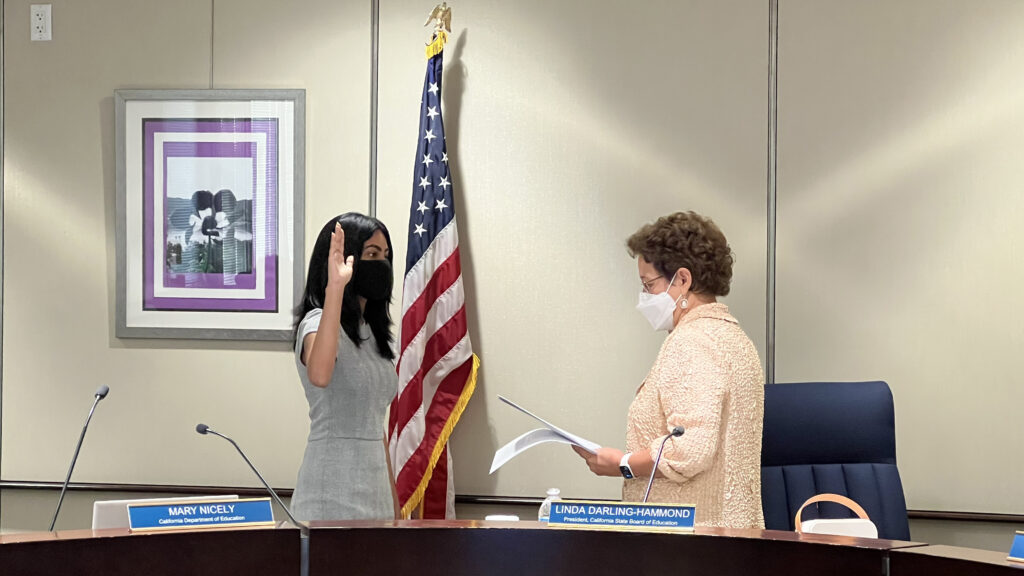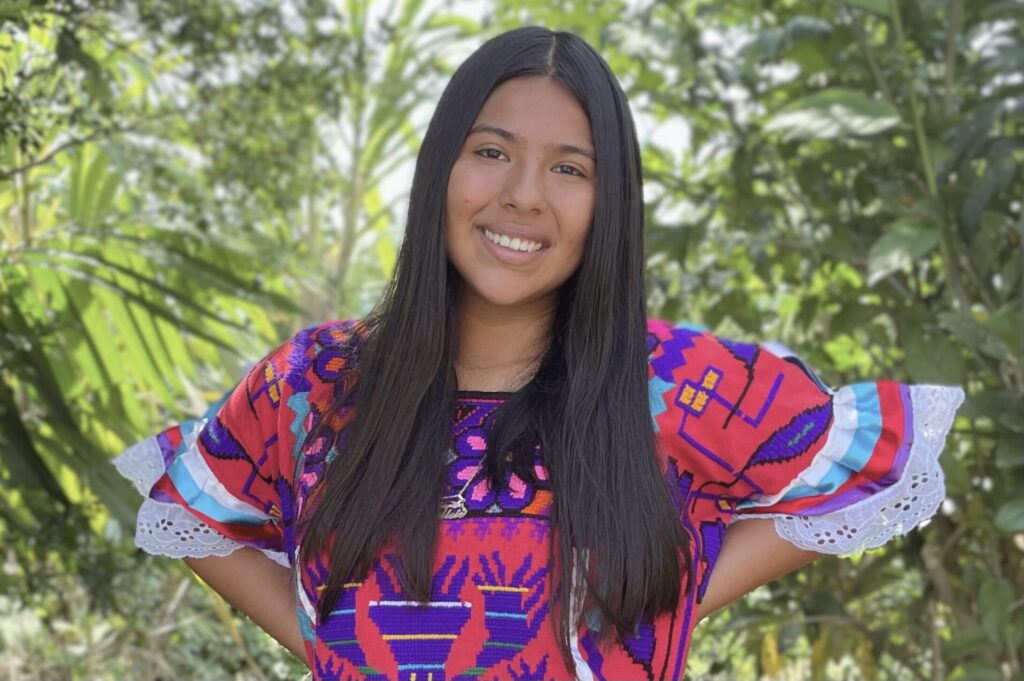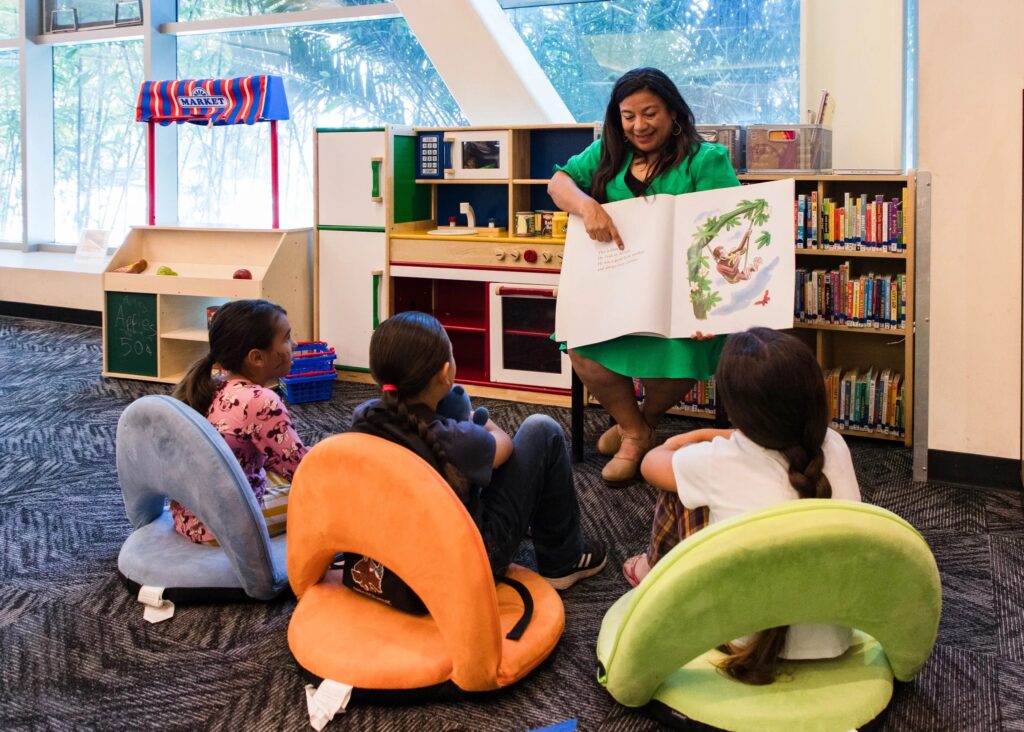
Credit: Courtesy of LAUSD/KLCS-TV
After hours of test taking last May, Karen Ramirez perked up when she saw a district leader and a camera crew walking onto her high school campus.
She had a hunch good news awaited.
Her instincts were right — then-17-year-old Ramirez was about to learn she had been elected as LAUSD’s student board member.
“I turned around, and I was like, ‘Wait, I think this means something happened,’” Ramirez, a senior at the Girls Academic Leadership Academy, said. “Eventually, I walked into my classroom because they brought cameras to film my reaction, and that’s when it hit. I was like, ‘Oh my goodness, I think I got it!’”
Since launching her campaign last February, Ramirez has made it her mission to promote student leadership across the district and to support the district’s Latino community.
“I know this is a position that not every student has in the district,” she said. “And to be able to be the one to experience all this, I feel very privileged.”
A path to the board
Ramirez’s path to LAUSD’s school board began when she was in the eighth grade and on LAUSD’s Superintendent’s Student Advisory Council, a group that meets with the superintendent several times each year to provide student input on the district’s efforts.
“I thought it would be a really nice idea to get an insider’s perspective into what’s going on,” Ramirez said. “Being able to see how (the committee has) evolved has definitely been an amazing thing.”
Ramirez has remained on the Superintendent’s Student Advisory Council since, tallying up nearly five years of district leadership. Being part of the board, she said, has been a “constant” in her educational journey.
One day during her junior year, an older mentor on the advisory council told her about the student position on the Los Angeles Unified School District board, and Ramirez’s campaign began.
“I started off just kind of thinking ‘Oh, OK, I just want to see what happens next,’ but then, as I got involved in the campaign process and started seeing how many students I would actually be representing in the district, that’s when it really became such a big passion for me,” she said.
“I know that my representation on the school board is something that is pretty big, especially for the Latino community.”
Last April, following an application and interview process, the district posted introductions to each of the position’s 10 finalists on its Instagram account, along with a brief speech made by each. Students then had two weeks to vote through an online portal.
“Everyone would start reposting on their Instagram stories, and they would all start campaigning for me on their own, and I didn’t even know that it was happening until after the fact, when I would talk to some friends who told me, ‘Oh, I voted for you!’” Ramirez said.
Elevating student voices on LAUSD’s school board
A critical forum for Ramirez to amplify student voices is through LAUSD’s school board meetings, where she speaks on behalf of students and co-sponsors resolutions, including one honoring Latino heritage.
Each month — and after a week of reviewing roughly 600 pages worth of materials and a summary in preparation for the board meeting — Ramirez is pulled out of school around 11:00 a.m., after her second period class, and is driven to downtown Los Angeles for the board meeting.
“Once I get there, I have lunch. I prepare, I look over all the board resolutions we might be discussing in the boardroom, and I take notes. I circle any things that might be relevant to students and that I might want to comment on,” Ramirez said. “And I also look for any board resolutions that I might want to co-sponsor.”
LAUSD’s student board members’ votes don’t technically count in board decisions, but they can introduce resolutions and can cast advisory votes, which school board member Tanya Ortiz Franklin said is “powerful” when making major decisions for the district.
Ramirez said it is vital that students’ voices are heard by school board members and the community at large, noting that district leadership often has to prioritize other challenges and communities.
“Sometimes the responsibilities that we (students) hold are big, but it’s not as big as what board members are doing. They have so much more on their plate,” Ramirez said, stressing the importance of providing students one-on-one attention.
“We are accessible, and (students) can reach out with any worries or comments, or just things that they want to see in the district. … I will always be attentive to the needs. … That’s the biggest thing.”
Ramirez also emphasized the importance of individual, one-on-one interactions, where she meets with students and encourages them to attend board meetings and join the various student councils at the district level, including an Asian American Pacific Islander council, individual board members’ councils and the Superintendent’s Student Advisory Council.
“Oftentimes, we feel a gap or lack of connectivity with our school board members, especially because our school board members are always on their platform … and so as students, a lot of times, we feel like we can’t really reach out to them,” Ramirez said. “My biggest thing is to really bridge that gap that we might feel.”
Bridging gaps
Beyond attending regular school board meetings, Ramirez has attended leadership conferences, appeared on television for Latino heritage month, reached out for collaboration with the Mexican Consulate and is working to launch a podcast later this year.
The podcast, she said, is in Spanish and will specifically cover topics pertinent to English learners. “That’s a community that’s really close to my heart and I always want to support,” she added.
Ramirez’s commitment to her heritage makes her stand out, Ortiz Franklin said.
“What’s so clear from Karen is how proud she is to be Latina, how privileged she feels to be a representative on the board in a district that is almost three-quarters Latino, and just what that means for immigrant families in particular, given how much of Los Angeles has been influenced by immigrant communities over the past generations,” Ortiz Franklin added.
Moving forward with confidence
Ramirez’s motivation to enter public service goes back to her parents, who encouraged her to take advantage of every opportunity.
“Some of the things that we … don’t have access to are things that you do have access to,” she remembers her parents telling her. “So if you have that opportunity, then you definitely have to take it.”
Ramirez said, “When I was told about the student board member position, and I knew that I had the opportunity to do something for my community as a whole, I thought that that was something that I couldn’t give up.”
Ramirez said her education at the Girls Academic Leadership Academy — LAUSD’s only all-girls school — has been especially formative in developing her confidence, not only as a board member, but as a leader in her high school’s student body and various clubs.
“Being in that environment around so many women, I felt like my confidence grew. In school, we always like to support each other,” Ramirez said. “I bring that confidence and that energy anywhere I go.”
Ramirez has accepted a scholarship to Yale University, and this fall she will become the first in her family to attend college.
“It’s an honor. I’m so excited to see how I experience that,” Ramirez said. “And anything that I learn there, I’ll bring that to my family and bring back to my community.”
Editors’ note: This story has been updated based on information made available after publication.







